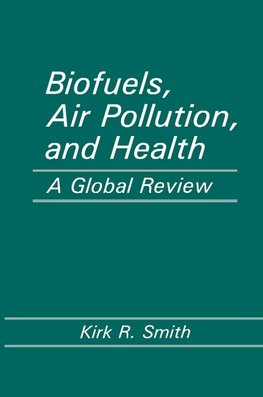
-
 Anglický jazyk
Anglický jazyk
Biofuels, Air Pollution, and Health
Autor: Kirk R. Smith
1. Recognition of the Problem: Views from Several Angles.- 1.1. Global Patterns of Fuel Use.- 1.2. Biofuel Combustion and Air Pollution.- 1.3. Indoor Air Pollution.- 1.4. A Synthesis.- 1.5. The Purpose and Organization of This Book.- 2. The Pollutants and... Viac o knihe
Na objednávku, dodanie 2-4 týždne
98.99 €
bežná cena: 109.99 €
O knihe
1. Recognition of the Problem: Views from Several Angles.- 1.1. Global Patterns of Fuel Use.- 1.2. Biofuel Combustion and Air Pollution.- 1.3. Indoor Air Pollution.- 1.4. A Synthesis.- 1.5. The Purpose and Organization of This Book.- 2. The Pollutants and Their Emission Factors.- 2.1. Traditional Biofuel Usage.- 2.2. Environmental Characteristics of Indicator Pollutants.- 2.2.1. Carbon Monoxide (CO).- 2.2.2. Particulates (TSP and RSP).- 2.2.3. Polycyclic Organic Matter (POM).- 2.2.4. Formaldehyde (HCHO).- 2.3. Measured Emission Factors.- 2.3.1. Carbon Monoxide (CO).- 2.3.2. Particulates.- 2.3.3. Polycyclic Organic Matter (POM).- 2.3.4. Formaldehyde (HCHO).- 2.4. Comparisons with Cigarette Smoke.- 3. Ventilation and Concentrations.- 3.1. Concentration Estimates: Simple Mathematical Models.- 3.1.1. Nonsteady-state Concentrations.- 3.1.2. Measured Air Exchange Rates.- 3.1.3. Estimated Concentrations.- 3.2. Concentration Estimates: Complex Models.- 3.3. Measured Concentrations.- 3.3.1. Carbon Monoxide (CO).- 3.3.2. Particulates.- 3.3.3. Polycyclic Organic Matter (POM).- 3.3.4. Formaldehyde (HCHO).- 3.4. Ambient Concentrations of Pollutants in Rural Areas.- 3.5. Concentrations Elsewhere and Air Quality Standards.- 3.5.1. Carbon Monoxide (CO).- 3.5.2. Particulates.- 3.5.3. Benzo(a)pyrene (BaP).- 3.5.4 Formaldehyde (HCHO).- 3.5.5. Comparisons Based on Hazard Indices.- 3.6. Comparisons with Cigarette Smoke.- 4. Exposures and Doses to Individuals and Populations.- 4.1. Estimates of Integrated Individual Exposures.- 4.1.1. Time Budgets.- 4.1.2. Measured Personal Exposures.- 4.2. Individual Dose Comparisons.- 4.2.1. Measured Individual Doses and Body Burdens.- 4.2.2. Estimated Individual Doses.- 4.3. Population Doses.- 4.4. Population Dose Commitments.- 4.5. Comparison with Doses from Cigarette Smoking.- 5. Estimating Health Effects by Extrapolation.- 5.1. Epidemiological Studies.- 5.1.1. Carbon Monoxide (CO).- 5.1.2. Particulates.- 5.1.3. Polycyclic Aromatic Hydrocarbons (PAH).- 5.1.4. Formaldehyde (HCHO).- 5.2. Evidence from the Literature on Smoking and Health.- 5.2.1. Cancer.- 5.2.2. Health Impacts Other Than Cancer.- 5.2.3. Women and Smoking.- 5.2.4. Passive Smoking.- 5.3. Other Lines of Evidence.- 5.3.1. Fire Fighters.- 5.3.2. Bioassays for Relative Hazard.- 5.3.3. Mutagens from Cooking Food.- 5.4. Conclusion to Extrapolation.- 6. Health Effects: Direct Evidence.- 6.1. Domestic Smoke Exposures: The Epidemiological Literature.- 6.1.1. Africa.- 6.1.2. Papua New Guinea.- 6.1.3. India.- 6.1.4. China.- 6.2. Nepal.- 6.3. Developed Countries.- 6.3.1. Woodsmoke in the United States.- 6.3.2. Gas Stoves in North America and Europe.- 6.4. Conclusions.- 7. Calculated Risks and Cold Reality.- 7.1. Sources of Ill-health in Developing Countries.- 7.1.1. Chronic Obstructive Lung Disease (COLD).- 7.1.2. Acute Respiratory Infections (ARI).- 7.1.3. Low Birth Weight and Associated Problems.- 7.1.4. Cancer.- 7.2. Priorities for Research.- 7.3. Anecdotal Evidence.- 8. Reducing Exposures: Fuels and Stoves.- 8.1. Stove Efficiencies.- 8.2. Fuel Characteristics Affecting Emissions.- 8.2.1. Fuel Composition.- 8.2.2. Moisture Content.- 8.2.3. Burn Rate.- 8.2.4. Size of Fuel Charges.- 8.2.5. Ratio of Fuel Load to Average Combustion Rate.- 8.2.6. Volume-to-Surface Ratio.- 8.3. Stove Design and Operating Characteristics.- 8.3.1. Combustion Enclosure.- 8.3.2. Temperature of Combustion.- 8.3.3. Excess Air.- 8.3.4. Preheated Primary Air.- 8.3.5. Mass.- 8.3.6. Interior Stove Dimensions.- 8.3.7. Time during Burn.- 8.3.8. Altitude.- 8.4. Comparisons.- 8.5. Fuel and Stove: A Tentative Summary.- 9. Other Remedies.- 9.1. Kerosene: The Fuel of Development.- 9.2. Upgraded Biofuels.- 9.2.1. Charcoal.- 9.2.2. Producer Gas and Biogas.- 9.2.3. Liquid Fuels.- 9.3. Flue Gas Control.- 9.3.1. Catalytic Conversion.- 9.3.2. Scrubbers and Filters.- 9.4. Ventilation Improvements.- 9.5. Loss of Smoke¿s Benefits.- 9.5.1. Mosquito Control.- 9.5.2. House Preservation.- 9.5.3. Food Drying and Smoking.- 9.5.4. Space Heating.- 9.6. Conclusion.- 10. Policy Implications.- 10.1. Rural Energy Policies.- 10.1.1. Fuels.- 10.1.2. Stoves.- 10.2. Rural Economic Development.- 10.2.1. Village Participation.- 10.2.2. The Challenge of Environmental Hazards.- 10.2.3. Rural Housing: Ventilation Improvements.- 10.3. The Status of Women.- 10.4. Public Health and Medical Care Delivery.- 10.5. Pollution Control Programs.- 10.5.1. Ambient Standards.- 10.5.2. Emission Standards.- 10.6. The Economics of Amelioration.- 10.6.1. Cost-Effectiveness of Exposure Control.- 10.6.2. Benefit-Cost Analysis of Exposure Control.- 10.7. Making Choices: The Bright and Dark Sides of Small is Beautiful.- Appendix A: What Happens When Wood Burns?.- Appendix B: Energy and Moisture Content in Wood.- Appendix C: Personal and Portable Monitors for Major Biofuel Air Pollutants.- Appendix D: Health Status of Rural Women in India (by Jamuna Ramakrishna).- Appendix E: Information Sources on Biofuel-Fired LDC Cookstoves.- References.
- Vydavateľstvo: Springer US
- Rok vydania: 2011
- Formát: Paperback
- Rozmer: 229 x 152 mm
- Jazyk: Anglický jazyk
- ISBN: 9781461282310











 Nemecký jazyk
Nemecký jazyk 
